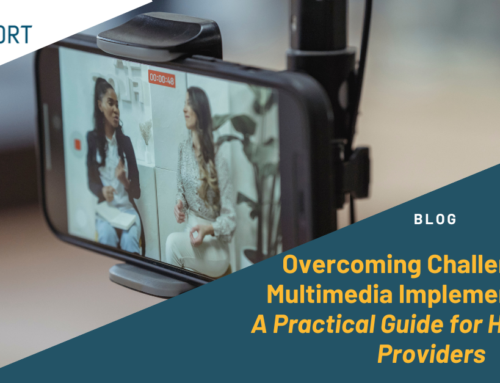Healthcare Videos and Interactive Tools for Patient Engagement: Making Education Participatory
This blog is the third installment in our series on healthcare videos and their impact on patient engagement and education. In our previous blog post, we explored how healthcare videos specifically address the unique challenges faced by cancer patients and their caregivers. This installment builds on that foundation, focusing on interactive tools that further enhance patient understanding and participation. These tools, which include quizzes, gamification, AI-generated healthcare videos, and virtual simulations, help transform patient education from a passive experience into an active, engaging process.
 Traditional methods—pamphlets, one-on-one explanations, and static images—often fall short in ensuring comprehension (read our article addressing those concerns).
Traditional methods—pamphlets, one-on-one explanations, and static images—often fall short in ensuring comprehension (read our article addressing those concerns).
The best way to improve patient understanding and retention is by making education interactive. Interactive tools empower patients to take an active role in their learning, leading to increased confidence in their treatment and better healthcare outcomes.
When patients participate in their own learning, they are more likely to retain information, feel confident about their treatment, and adhere to medical guidance.
Let’s explore how interactive tools are making this shift possible and the real-world impact they are having.
Examples of Interactive Tools Enhancing Patient Engagement
1. Quizzes to Reinforce Learning
Quizzes are a simple yet effective way to assess patient comprehension and reinforce key information. By answering multiple-choice or scenario-based questions, patients can immediately apply what they have learned. This method also helps healthcare providers understand how to evaluate patient understanding.
2. Gamification: Making Learning Fun
Gamification uses elements like rewards, challenges, and progress tracking to engage patients in their own education. One example is Re-Mission, a video game designed for young cancer patients, where players ‘fight’ cancer cells. Research shows that this gamified approach improves treatment adherence and patient motivation, leading researchers to better understand how to evaluate patient understanding.
3. AI-Generated Healthcare Videos for Personalized Education
Platforms like 5thPort use AI to create customized patient education healthcare videos. These healthcare videos explain treatment options, risks, and procedures in an easy-to-understand format, tailored to the individual. 5thPort implemented a digital engagement platform in a radiation oncology department, allowing patients to review informed consent materials at home. This initiative resulted in patients arriving fully educated, leading to more efficient appointments and higher satisfaction rates.
4. Virtual Simulations for Immersive Learning
Virtual reality (VR) and augmented reality (AR) allow patients to experience medical procedures in a simulated environment before undergoing them in real life. In a 2023 study titled, “An Affordable Platform for Virtual Reality–Based Patient Education in Radiation Therapy,” published in Practical Radiation Oncology, the researchers developed a cost-effective, smartphone-based VR platform designed to immerse patients in their treatment journey, from simulation through initial delivery. Patients who utilized this VR experience reported feeling more prepared and less anxious about their upcoming radiation therapy sessions.
Tools and Software for Creating Interactive Content Include…
If you’re looking to incorporate interactive patient education into your healthcare practice, and learn how to evaluate patient understanding, here are some tools that can help:
- H5P – Open-source platform for creating interactive quizzes, presentations, and videos. (Link)
- Adobe Captivate – Authoring tool for eLearning content, including simulations and quizzes. (Link)
- iSpring Suite – PowerPoint-based toolkit for interactive courses, quizzes, and video lectures. (Link)
- ActivePresenter – Screen recording and eLearning tool for creating interactive content. (Link)
…However, 5thPort already integrates many of these capabilities into a single, cohesive platform…
While all of these tools are valuable for creating interactive patient education content, it’s important to recognize that 5thPort already integrates many of these capabilities into a single, cohesive platform. Instead of piecing together various software solutions and hoping they work well together, 5thPort offers a seamless experience with built-in features, including:
- Quizzes to assess patient comprehension
- Documentation and link-back capabilities for reference materials
- Question-and-answer functionality for patient-provider interactions
- Section flagging to highlight critical information
- Videos – both self-recorded and AI-generated avatar-based healthcare videos
- Presentation uploads to enhance educational materials
The Future of Patient Education is Fully Participatory
Patient education should never be a passive experience. A truly participatory approach—where patients actively engage with quizzes, videos, simulations, and interactive materials—creates deeper understanding and lasting behavioral change. By leveraging a comprehensive platform like 5thPort and its healthcare videos generation, providers can ensure their education strategies are not only effective but also seamlessly integrated.
As technology continues to advance, the healthcare industry must continue embracing innovative solutions that empower patients. The future of patient engagement is not just about delivering information—it’s about fostering meaningful, interactive learning experiences that lead to better care outcomes. Let’s make patient education participatory, effective, and truly impactful.
To schedule a demo or receive more information email us at Info@5thPort.Com.
This article is part of a series by 5thPort exploring the transformative potential of video-based multimedia in healthcare. Stay tuned for part #4.




